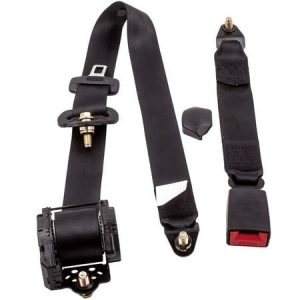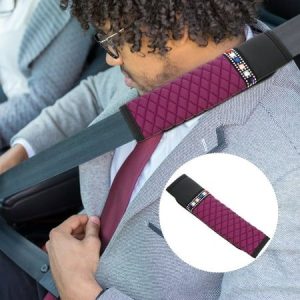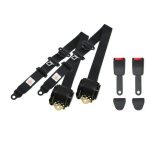Ever climbed into your car, buckled up for safety, and then found yourself inexplicably stuck? It can be a frustrating situation, especially if you’re in a hurry. The culprit behind this predicament is most likely the seat belt’s auto-lock feature, a safety mechanism designed to keep you securely fastened in the event of a sudden stop or collision.But fear not! While the auto-lock is there to protect you, there are safe and simple ways to release it when necessary. This guide will equip you with the knowledge to handle a stuck seat belt situation calmly and effectively.
Understanding the Seat Belt Auto-Lock
Modern seat belts incorporate a variety of safety features, including the auto-lock mechanism. This ingenious design automatically engages the retractor when a certain amount of force is exerted on the belt, preventing it from webbing out freely. This is particularly crucial during emergencies to ensure occupants remain securely restrained.

However, the auto-lock can sometimes become engaged unintentionally, leaving you feeling trapped. This can occur due to a variety of factors, such as:
- Improper belt positioning: If the seat belt is twisted or not inserted smoothly into the buckle, the auto-lock might activate.
- Rapid movement: A sudden jerk or quick movement while buckled up can trigger the auto-lock.
- Faulty mechanism: In rare cases, a malfunctioning auto-lock mechanism might be the culprit.
Releasing the Auto-Lock: Simple Solutions
Before resorting to drastic measures, here are some straightforward methods to release a stuck seat belt auto-lock:
-
Gentle Pressure and Release: The most common solution involves applying gentle, steady pressure on the seat belt while simultaneously pressing the release button on the buckle. This technique often resets the auto-lock and allows the belt to retract smoothly.
-
Adjust the Position: Sometimes, a simple adjustment can do the trick. Try sitting up straight and ensuring the seat belt lies flat against your body without any twists or folds. Then, carefully attempt to release the buckle while maintaining proper positioning.
-
Controlled Release and Re-Buckle: If the above methods fail, you can try a controlled release and re-buckle technique. Hold the seat belt firmly near the buckle to prevent it from webbing out completely. Then, press the release button and slowly guide the belt out of the buckle. Once released, re-insert the belt into the buckle and ensure it’s properly secured.
Important Note: Never attempt to force the seat belt mechanism or cut the belt. These actions can compromise the integrity of the seat belt and render it ineffective in a crash.
Advanced Techniques (Use with Caution)
If the basic methods prove unsuccessful, there are a few additional techniques you can attempt, but proceed with caution:

-
Emergency Release Latch (if equipped): Some vehicles, particularly older models, might have a hidden emergency release latch located near the buckle. Consult your car’s owner’s manual for specific instructions on locating and using this latch.
-
Manual Override (not recommended): This method involves manually overriding the auto-lock mechanism by accessing the internal components of the seat belt retractor. However, this is a delicate process that can potentially damage the seat belt and should only be attempted as a last resort, and ideally by a qualified mechanic.
If you’re unsure about any of these advanced techniques, it’s always best to err on the side of caution and seek professional help.
Preventing Auto-Lock Mishaps: Buckle Up for Smooth Sailing
Here are some tips to minimize the chances of encountering a stuck seat belt auto-lock:
-
Smooth Insertion: Always ensure the seat belt webbing is inserted smoothly and flatly into the buckle to prevent snags or misalignment.

-
Maintain Proper Posture: Sit upright with your back against the seat and avoid excessive slouching or twisting, which can put tension on the belt and activate the auto-lock.
-
Regular Maintenance: Schedule routine vehicle maintenance checks to ensure the seat belt system, including the auto-lock mechanism, is functioning properly.
By following these preventative measures, you can enjoy a smoother and safer driving experience.
When to Seek Professional Help
If, after attempting the recommended techniques, your seat belt remains stuck, it’s advisable to seek professional assistance. A qualified mechanic can diagnose the problem and ensure your seat belt system is functioning optimally for your safety.
Invest in Safety: Consider Upgrading Your Seat Belt System
Modern car manufacturers are constantly innovating to improve seat belt technology. While the auto-lock mechanism is a valuable safety feature, some newer models offer additional functionalities that enhance comfort and convenience. Here are a few examples:

- Pretensioners: These systems automatically tighten the seat belt in the event of a crash, further reducing slack and minimizing occupant movement.
- Load limiters: These features are designed to release a small amount of slack in the belt during a crash to reduce the risk of chest injuries.
- Automatic Seat Belts: These advanced systems are still under development but hold promise for the future. They could automatically tighten and adjust the seat belt upon entering the vehicle, ensuring proper fit for all passengers.
While upgrading your car might not be an immediate option for everyone, familiarizing yourself with these advancements can help you make informed decisions when purchasing a new vehicle in the future.
Buckle Up with Confidence: Call to Action
Now that you’re equipped with the knowledge to handle a stuck seat belt auto-lock and ensure proper seat belt use, it’s time to prioritize your safety on the road. Make buckling up a habit!
Here are some ways to solidify this safe practice:

- Be a role model: Always buckle up yourself and encourage your passengers to do the same. Lead by example and foster a culture of seat belt safety in your car.
- Talk to your teens: As your teenage children prepare to get behind the wheel, have open conversations about the importance of seat belt use. Discuss the consequences of not wearing a seat belt and emphasize their responsibility as drivers.
- Support seat belt laws: Advocate for strong seat belt laws in your community. Effective enforcement sends a clear message that seat belt use is not optional, it’s the law.
By taking these steps, you can become an ambassador for seat belt safety. Remember, every ride is an opportunity to buckle up and make a positive impact on road safety.
Looking to prioritize safety in your next car purchase? Consider exploring vehicles equipped with advanced seat belt features like pretensioners, load limiters, or automatic seat belt technology. Research car dealerships or online resources to find vehicles that boast cutting-edge advancements in seat belt technology, putting your safety first on every journey.


